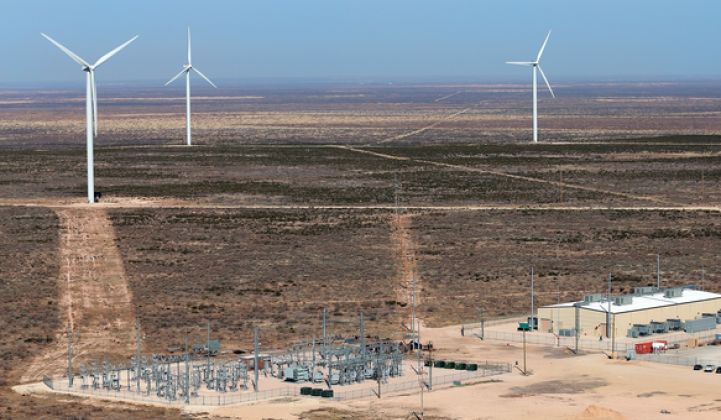Utilities are leery of new battery technologies, no matter how groundbreaking they seem. That's because they sometimes don’t perform as promised, and fixing that problem can turn out to be an expensive proposition.
Last week, Duke Energy announced it is “repowering” its 36-megawatt, 24-megawatt-hour energy storage project at the Notrees wind farm in Texas. Over the next 18 months or so, Duke will be replacing the facility’s advanced lead-acid batteries, built by bankrupt startup Xtreme Power, with lithium-ion batteries from Samsung SDI. The plan is to have the last Xtreme systems out by the end of next year.
“When we began participating more and more in ERCOT’s fast-responding regulation service market, we found the original technology was not the best fit for the purpose we were using it [for],” Duke spokesperson Tammie McGee said in an email last week. “We expect the lithium-ion batteries to follow demand much more quickly. They’ll boost rapid response capabilities, optimize the life/output of the batteries, and lead to a higher level of performance.”
Duke declined to disclose how much this repowering will cost. Nor would Younicos, the German energy storage control system provider that bought Xtreme Power’s assets out of bankruptcy last year. That company now operates Xtreme's remaining installations, including Notrees.
“You have to remember that, as lead-acid ages, it becomes a lot less able to withstand the rapid charging and discharging action that frequency regulation demands, at least in the ERCOT market,” Audrey Fogarty, Younicos’ vice president of product management, said in a phone interview last week.
Younicos isn’t building Xtreme’s lead-acid batteries anymore. The startup shuttered its factory in 2013, about eight months before it filed for bankruptcy protection, claiming that it was unable to support the business of building and financially backing its own batteries on a startup’s budget.
The track record for the 60 megawatts of batteries that Xtreme did deploy seems to indicate another set of challenges for its decades-old version of lead-acid battery chemistry. While some systems haven’t reported problems, others have had issues that range from the catastrophic to the disappointing.
On the catastrophic side of the ledger, a 15-megawatt Xtreme battery system backing First Wind's Kahuku wind farm on Hawaii’s Oahu island burned to the ground in 2012. While the cause of the fire remains uncertain, the fire did have a decided chilling effect on Xtreme’s ability to sell new systems, according to people in the industry.
What's more, other Xtreme batteries that didn’t burn down haven’t impressed their owners. In January, a report from MIT Technology Review noted that Hawaii’s Kauai Island Utility Cooperative has also replaced its Xtreme batteries, installed to mitigate frequency fluctuations from a solar farm, with lithium-ion batteries from Saft.
Brad Rockwell, the utility’s power supply manager, said that the utility found out soon after turning the system on in late 2012 that Xtreme’s battery was “just not what it was cracked up to be.” While it was designed to last eight years, it had “very little” capacity left after only two years of operation.
It’s unclear whether Duke and Younicos have experienced a similar degradation of the Xtreme batteries at the Notrees facility, since both declined to comment specifically on the subject.
Duke won a $22 million DOE smart grid demonstration grant in 2009 to build the Notrees storage facility -- the largest of its kind at the time -- and matched that amount from its own coffers. The system has been running since the first quarter of 2013, and it was built to demonstrate the capability to perform multiple applications, including wind power balancing and frequency regulation, Fogarty said.
According to a 2014 DOE report (PDF), the Notrees facility did perform well in the fast-responding regulation service market tests with Texas grid operator ERCOT, and it has continued to bid into the market since then. But it’s likely that Duke had hoped that the Xtreme batteries serving this market would have been able to last longer than two years.
“Duke sees this as a clear commercial benefit, repowering to allow them to continue operating in the market,” Fogarty said. “Each chemistry is going to be subject to different types of degradation, depending on its characteristics, and depending on how it’s used. I think there’s much more appreciation and knowledge in the marketplace to match certain uses with different chemistries.”
This isn’t the only example of grant-funded energy storage projects that haven’t performed as well as expected. Nor is it the only one to have been built by a company that has since gone under, as the example of bankrupt flow battery startup EnerVault and its DOE-funded project in Turlock, Calif. shows.
But as one of the biggest grid storage systems in the country, the Notrees repowering is likely to become one of the stories that makers of novel battery chemistries will have to contend with when seeking financial backing and utility partners to demonstrate their systems in the field.



